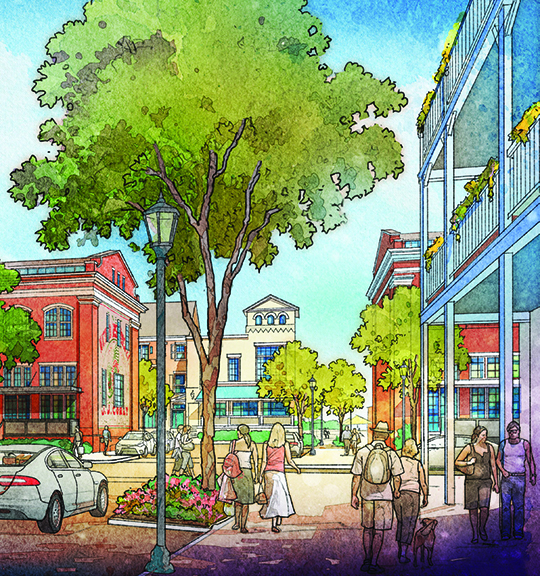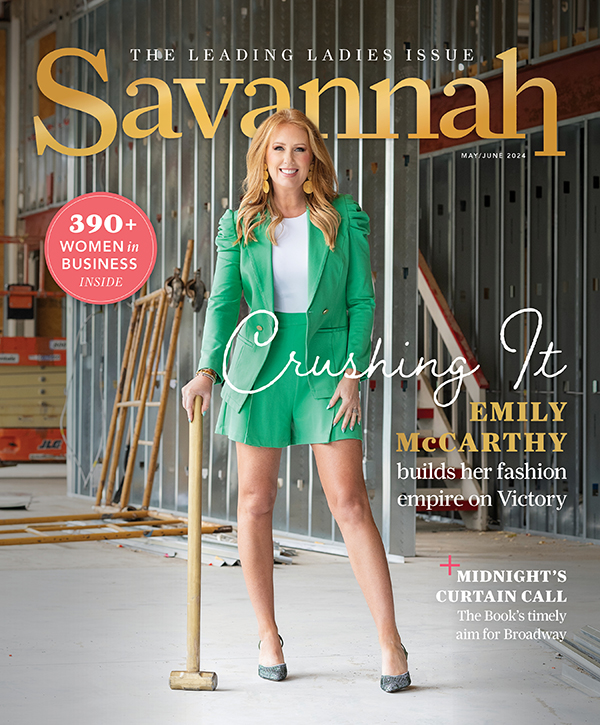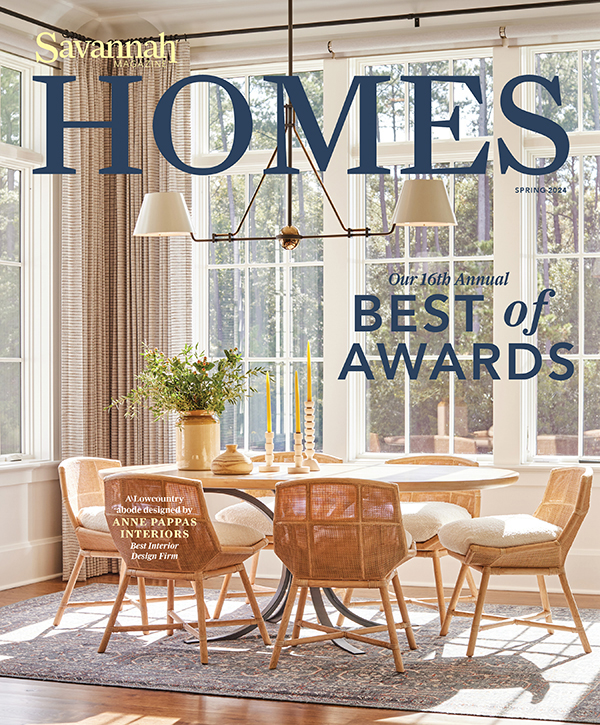Building a new neighborhood one hand-tumbled brick at a time
The Savannah River is a maritime portal to some of the city’s most famous sights: the Talmadge Memorial Bridge, the gold leaf dome of City Hall, the cobblestone streets dating back hundreds of years, the Waving Girl statue simultaneously greeting visitors and bidding them adieu. Its main thoroughfare, River Street, hums with activity day and night — and into the wee hours of the morning — and that action largely revolves around tourists. As Savannah continually gains exposure — last year, Travel+Leisure dubbed it the No. 3 best city in the U.S. for its annual rankings — the area along the river has become increasingly crowded, perhaps too busy to draw locals for dinner or date night. As the Hostess City of the South, we certainly know how to entertain out-of-towners, but what about a locally focused development — with tantalizing views of the river, too?
Enter developer Patrick Malloy, whose astute and ambitious plan will turn an untapped waterfront swath of land just east of downtown into homes designed first and foremost with Savannahians in mind. Part of the Eastern Wharf revitalization, Malloy’s Upper East River neighborhood will offer a variety of home sizes and styles ranging from slick, industrial-minded builds to distinguished townhomes to four-story river homes with detached carriage houses and elevated courtyards across 10 prime acres (the larger Eastern Wharf project includes 54 acres total). All good things — and, here as ever, good things come to those who wait.
“We capitalized our project with 100 percent equity, and we did that because we wanted to have the luxury of time,” Malloy says. “We think we will build the whole neighborhood in about six years or so, but we want it to look like it evolved naturally over 100 years.” That means agonizing over every single design decision: Malloy recalls how his team reviewed hand-tumbled brick styles and types and shades of mortar, ultimately changing it up on certain homes for historical accuracy and aesthetic continuity.
The area, called the Eastern Wharves District during the 1800s, was home to prosperous businesses like the A.N. Miller’s Foundry, the Hydraulic Cotton Press Company and the Bullock and Winton Steam Saw Mill. The success of these industries helped boost Georgia’s economic growth. But with boom came bust — the wharves’ prosperity waned starting in 1945, when the newly formed Georgia Ports Authority consolidated much of Savannah’s shipping industry, moving goods through larger deepwater ports west of downtown. A decidedly more recent bust followed in 2006, when a previous plan to develop the area failed. Malloy is well aware of the project’s baggage, but he’s self-assured: his Atlanta-based company, Patrick Malloy Communities, endured the recession, too, and made it through the other side leaner, but savvier.
“We were a pretty large homebuilding company, and we had to become a small one,” he says. “We had to learn how to find treasure in distressed assets — we bought a distressed hotel, a distressed bank, numerous distressed neighborhoods. We’ve gotten good over the last 13 or so years at identifying opportunities that failed not because of anything other than just terrible timing.”
So, in addition to facing failure head on, how does Malloy overcome the stigma associated with the Eastern Wharf area?
“You have to execute from day one at the very highest level in everything you do. I don’t expect anybody to just believe that we’re going to do a great job. They need to see it.”

One such example of Upper East River’s five home styles is the Adler, named for lauded Savannah preservationist Leopold Adler II (the name is a testament to the project’s build-it-right mentality, and Malloy secured the Adler family’s permission, of course). This rowhouse style evokes homes you might see along Gaston or Jones or Charlton streets, first popularized during the early 19th century as a space-conserving design for urban areas. The Adler boasts options like curved staircases and wine cellars; open floor plans and premium finishes come standard.
Lead architect Jeff Hamilton designed the Adler, along with four other home types drawing on architectural styles from the 18th, 19th and early 20th centuries, in concert with a team of outside architects all primed to avoid anything cookie-cutter. “When you have five styles of homes that are highly customized and within a small site, it’s very complicated,” Malloy says. “It’s a complex process that requires a lot of thoughtful work from a lot of smart people.”
This contingent of creative minds generated an abundance of carefully considered design elements: the Juliet balconies on the Hamilton style, extending over the sidewalk for passersby to marvel at (Malloy got a special permit to build them this way); the elevated courtyards of the River Home style, offering cross-ventilation and a great breeze, with views of the river in every direction; the elevators of the Mayors style, bringing residents directly up to their own private floor; the porch evoking the look and feel of a loading dock on the JJ Corry style, named for an Irish whiskey company in which Malloy is an investor and part owner and paying homage to Savannah’s port-city past.
In addition to these luxury residences, the area will also include shops, restaurants, offices and a hotel, all of which have been just as thoughtfully designed. Before he agreed to work with Regent Partners, the group behind the commercial portion of Eastern Wharf, Malloy thoroughly investigated their track record and resume, he says. “It’s critical to us that all the homeowners get to enjoy the amenities, which include first and foremost Savannah and the river, but also the stuff that’s being built right next to us.”
Despite building some 40 communities and 5,000 homes, Malloy had never worked outside of the Atlanta market. When the opportunity arose to build a new neighborhood in Savannah, “one of the coolest cities on the Eastern seaboard” in his estimation — and the only one with this kind of real estate available — well, Malloy couldn’t pass it up. But he won’t just be passing through, either: he’s buying a home in Upper East River. As a builder, an urban steward and soon, as a neighbor, Malloy’s sincere hope is that after residents begin moving in next spring, Savannahians at large will consider the neighborhood a natural extension of this centuries-old city.
“I didn’t come down here to build a community and leave. I hope locals will embrace it,” Malloy says, adding a perceptive caveat: “After we prove ourselves.”


